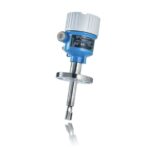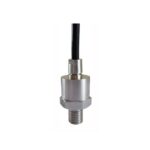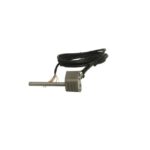A miniature magnetic mount vibration sensor is a compact device designed to detect and measure mechanical vibrations in machinery, leveraging magnetic attachment for quick installation.
1. Core Mechanism
Sensing Technology: Most miniature magnetic mount vibration sensors use a piezoelectric element or MEMS (Micro-Electro-Mechanical Systems) accelerometer. When vibrations occur, the inertial force from a built-in seismic mass deforms the sensing element, generating an electrical signal proportional to the acceleration.
Magnetic Mount: The sensor’s base incorporates a strong permanent magnet, allowing it to attach securely to ferromagnetic surfaces (e.g., steel machinery). This ensures direct vibration transfer without screws or adhesives.
2. Working Principle
Vibration Detection:
As the monitored equipment vibrates, the vibration sensor’s magnetic base moves synchronously with the surface.
The internal sensing element (e.g., piezoelectric crystal or MEMS structure) converts mechanical stress into an electrical signal (charge or voltage).
Signal Output:
3. Integrated circuitry amplifies and conditions the raw signal, providing standardized outputs like 4–20 mA, 0–5 V, or digital formats (e.g., SPI/I²C for MEMS-based sensors).
4. High-frequency noise is filtered to ensure accuracy within the sensor’s bandwidth (e.g., 10 Hz–5 kHz).
3. Key Features
Miniature Design: Compact size enables installation in tight spaces, ideal for portable or temporary monitoring.
Magnetic Mount Advantage: The vibration sensor can be rapidly repositioned, making it perfect for diagnostics or multi-point inspections.
Environmental Resilience: Often rated IP65 or higher, resistant to dust, oil, and moderate shocks.
4. Applications
Predictive Maintenance: Temporary monitoring of motors, pumps, or bearings to detect imbalances or wear.
Field Diagnostics: Engineers use the vibration sensor for on-site troubleshooting without permanent mounting.
Research & Testing: Capturing vibration data in prototypes or lightweight structures.
Limitations:
Surface Dependency: Requires ferromagnetic materials for secure attachment (non-magnetic surfaces need adapters).
Frequency Range: Miniature sensors may sacrifice ultra-low-frequency performance for size.
This vibration sensor balances portability, ease of use, and precision, making it a versatile tool for industrial and experimental vibration analysis. For specific specs, refer to the manufacturer’s datasheet.





